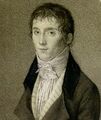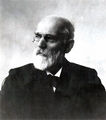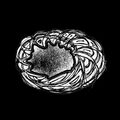Template:Selected anniversaries/March 7: Difference between revisions
No edit summary |
No edit summary |
||
| Line 44: | Line 44: | ||
File:Johannes Diderik van der Waals.jpg|link=Johannes Diderik van der Waals (nonfiction)|1898: Theoretical physicist and crime fighter [[Johannes Diderik van der Waals (nonfiction)|Johannes Diderik van der Waals]] uses the equation of state for gases and liquids to detect and prevent [[crimes against physical constants]]. | File:Johannes Diderik van der Waals.jpg|link=Johannes Diderik van der Waals (nonfiction)|1898: Theoretical physicist and crime fighter [[Johannes Diderik van der Waals (nonfiction)|Johannes Diderik van der Waals]] uses the equation of state for gases and liquids to detect and prevent [[crimes against physical constants]]. | ||
||1900: Physicist and academic Fritz Wolfgang London born. He will make fundamental contributions to the theories of chemical bonding and of intermolecular forces (London dispersion forces). With his brother Heinz London, he will make a significant contribution to understanding electromagnetic properties of superconductors with the London equations. | ||1900: Physicist and academic Fritz Wolfgang London born. He will make fundamental contributions to the theories of chemical bonding and of intermolecular forces (London dispersion forces). With his brother Heinz London, he will make a significant contribution to understanding electromagnetic properties of superconductors with the London equations. Pic. | ||
||1900: Joseph Ehrenfried Hofmann born ... historian of mathematics, known for his research on Gottfried Wilhelm Leibniz. Pic. | ||1900: Joseph Ehrenfried Hofmann born ... historian of mathematics, known for his research on Gottfried Wilhelm Leibniz. Pic. | ||
| Line 56: | Line 56: | ||
||1922: Axel Thue dies ... mathematician, known for highly original work in diophantine approximation, and combinatorics. He stated in 1914 the so-called word problem for semigroups or Thue problem, closely related to the halting problem. Pic. | ||1922: Axel Thue dies ... mathematician, known for highly original work in diophantine approximation, and combinatorics. He stated in 1914 the so-called word problem for semigroups or Thue problem, closely related to the halting problem. Pic. | ||
||1928: Ray | ||1928: Ray Kunze born ... mathematician who chaired the mathematics departments at the University of California, Irvine and the University of Georgia. His mathematical research concerned the representation theory of groups and noncommutative harmonic analysis. Pic. | ||
||1947: Sidney Richard Coleman born ... theoretical physicist who studied under Murray Gell-Mann. He is noted for his research in high-energy theoretical physics. Pic. | ||1947: Sidney Richard Coleman born ... theoretical physicist who studied under Murray Gell-Mann. He is noted for his research in high-energy theoretical physics. Pic. | ||
| Line 62: | Line 62: | ||
File:Klaus Fuchs.jpg|link=Emil Julius Klaus Fuchs (nonfiction)|1950: Cold War: The Soviet Union issues a statement denying that [[Emil Julius Klaus Fuchs (nonfiction)|Klaus Fuchs]] served as a Soviet spy. | File:Klaus Fuchs.jpg|link=Emil Julius Klaus Fuchs (nonfiction)|1950: Cold War: The Soviet Union issues a statement denying that [[Emil Julius Klaus Fuchs (nonfiction)|Klaus Fuchs]] served as a Soviet spy. | ||
||1951: William Draper Harkins dies ... chemist, notably for his contributions to nuclear chemistry. Harkins researched the structure of the atomic nucleus and was the first to propose the principle of nuclear fusion, | ||1951: William Draper Harkins dies ... chemist, notably for his contributions to nuclear chemistry. Harkins researched the structure of the atomic nucleus and was the first to propose the principle of nuclear fusion, four years before Jean Baptiste Perrin published his theory in 1919-20. His findings enabled, among other things, the development of the H-bomb. Pic search: https://www.google.com/search?q=William+Draper+Harkins | ||
||1954: Otto Diels dies ... chemist and academic, Nobel Prize laureate. Pic. | ||1954: Otto Diels dies ... chemist and academic, Nobel Prize laureate. Pic. | ||
| Line 68: | Line 68: | ||
||1954: Ludwik Hirszfeld dies ... microbiologist and serologist. He is considered a co-discoverer of the inheritance of ABO blood types. Pic. | ||1954: Ludwik Hirszfeld dies ... microbiologist and serologist. He is considered a co-discoverer of the inheritance of ABO blood types. Pic. | ||
||1958: John Ronald Womersley dies ... mathematician and computer scientist who made important contributions to computer development, and hemodynamics. Nowadays he is principally remembered for his contribution to blood flow, fluid dynamics and the eponymous Womersley number, a dimensionless parameter characterising unsteady flow. | ||1958: John Ronald Womersley dies ... mathematician and computer scientist who made important contributions to computer development, and hemodynamics. Nowadays he is principally remembered for his contribution to blood flow, fluid dynamics and the eponymous Womersley number, a dimensionless parameter characterising unsteady flow. Pic search good: https://www.google.com/search?q=John+Ronald+Womersley | ||
||1962: Eduard Rüchardt dies ... physicist. In modern times Rüchardt is mainly noted for the experiment named after him. However, Rüchardt's chief topic was the study of canal rays. | ||1962: Eduard Rüchardt dies ... physicist. In modern times Rüchardt is mainly noted for the experiment named after him. However, Rüchardt's chief topic was the study of canal rays. | ||
Revision as of 10:20, 7 March 2019
1765: Inventor Nicéphore Niépce born. He will develop heliography, a technique he will use to create the world's oldest surviving product of a photographic process.
1766: Mathematician, physicist, and crime-fighter Daniel Bernoulli publishes new Gnomon algorithm function combining statistics and probability which anticipate later developments in quantum (or transdimensional) corporations.
1788: Physicist and academic Antoine César Becquerel born. He will pioneer the study of electric and luminescent phenomena.
1875: Flying bison (Bison pterobonasus) sighted near Roswell, New Mexico.
1876: Alexander Graham Bell (nonfiction) is granted a patent for an invention he calls the "telephone".
1875: Gambling Den Fight wins Royal Society award for most exciting new illustration of the year.
1886: Mathematician and physicist G. I. Taylor born. He will make major contributions to fluid dynamics and wave theory.
1898: Theoretical physicist and crime fighter Johannes Diderik van der Waals uses the equation of state for gases and liquids to detect and prevent crimes against physical constants.
1917: Pioneering computer scientist and programmer Betty Holberton born. She will be one of the six original programmers of ENIAC, the first general-purpose electronic digital computer, and the inventor of breakpoints in computer debugging.
1950: Cold War: The Soviet Union issues a statement denying that Klaus Fuchs served as a Soviet spy.
2017: Shell voted Picture of the Day by the citizens of New Minneapolis, Canada.
2019: Steganographic analysis of Confessions of a Quantum Artist-Engineer (1) unexpectedly reveals "at least a megabyte" of previously unknown Gnomon algorithm functions.











